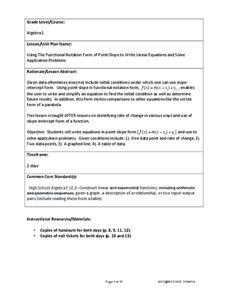Curated OER
Table Mazes Using Microsoft Word
Young scholars use the table feature of Microsoft Word to construct a solvable maze. They incorporate clip art and WordArt into their mazes. Students create a table and use word processing functions to design a maze. They create...
Curated OER
Biography Report- Learning Microsoft Word
Students learn how to use Microsoft Word. In this biography lesson, students participate in mini-lessons on key features of Microsoft Word and then use it to write a multi-part biography report.
LABScI
Atomic Structure and the Periodic Table of Elements: The Secret Agent Lab
Food always gets attention! Model atomic structure using fruit loops to represent the subatomic particles. After building models, scholars create ionic bonds using their models. Finally, they use these concepts to create a periodic table.
Curated OER
Word Processing With Pizazz
Students use a word processor and some of its tools to create an exciting and visual autobiography. They download a sample letter and then create one of their own.
Curated OER
Table This!
Students create a table in Microsoft Word. In this word processing lesson, students create a table in Microsoft Word. They fill this table in as if it were a BINGO card, but they use their vocabulary words instead of numbers.
Curated OER
Inserting Tables
Students practice creating tables using Microsoft Word. They insert tables into Microsoft Word pages to create calendars complete with images. Step by step instruction pages are provided for student use.
Curated OER
Table Mazes Using Microsoft Word
Students create a table and use word processing functions to design a maze. They use the table feature of Microsoft Word to construct a solvable maze and incorporate clip art and Word Art into their mazes. They use Word Art to add a...
Curated OER
Background of Diseases-- Germs or Genes?
Students explore the background of common diseases. In this personal health lesson, students research causative agents of communicable and non-communicable diseases. Students use their research findings to create data tables in Microsoft...
Curated OER
"Lettuce" Learn About the Water Cycle
Young scientists investigate the water cycle through a lettuce seed experiment. For this experiment, learners plant lettuce seeds inside of a ziplock bag in order to create a small greenhouse. They observe condensation and precipitation,...
Curated OER
Create a Table
Students set up a simple table in Microsoft Word. They assess the terms columns and rows and compare the bingo card to a table, that will be created in Microsoft Word. They insert text files, graphics, or other objects into an existing...
Curated OER
Interpreting Graphs
Sixth graders interpret linear and nonlinear graphs. They create graphs based on a problem set. Next, they represent quantitive relationships on a graph and write a story related to graphing.
Curated OER
Data Analysis and Probability: Graphing Candy with Excel
Collect and graph data using Microsoft Excel with your math class. They will make predictions about the number of each colored candy in a bag of M&M's, then sort, classify, count, and record the actual data before using Excel to...
West Contra Costa Unified School District
Point-Slope Application Problems
Create a linear equation for a problem when the intercept information is not given. The two-day lesson introduces the class to the point-slope form, which can be used for problems when the initial conditions are not provided. Pupils...
Curated OER
Multiplication Tables Using Microsoft Excel
Eighth graders are introduced to Microsoft Excel as a computer application software program. They create multiplication tables in Microsoft Excel. Students work in small groups. They discuss the $ (anchor) function in Microsoft Excel.
Curated OER
The Periodic Table
Students examine the periodic table and how it was developed. In this chemistry lesson students identify common properties and uses of elements within a family.
Curated OER
Function Tables
Fourth graders explore the concept of function tables. In this function tables lesson, 4th graders compare the star machine in The Sneeches to function tables in math. Students practice creating and solving function tables.
Curated OER
Going Graph-y
Second graders listen to and dicuss the story Where the Wild Things Are. They play a pantomime game and act out various feelings so their classmates can guess. They listen for the frequency of certain words, and record their findings on...
Aquarium of the Pacific
Lego Molecules
Young scientists construct an understanding of molecular compounds in this hands-on science lesson plan. Using LEGO® to model the atoms of different elements, students build molecules based on the chemical formulas of common compounds.
Math Can Take You Places
Picture This
Engage scholars in a ratio lesson that employs real-world scenarios. Learners will compare the length and width of pictures and use a table to identify ratio patterns. They watch "Math Can Take You Places" and discuss jobs that use math...
Curated OER
Globalization Comes to the Table
Students, in groups, research the issues surrounding one of several controversies involving food and globalization. Then they debate their position and show a PowerPoint presentation at a mock summit meeting.
Curated OER
Graphing with Stems-and -Leafs
Fourth graders examine the use of stem and leaf graphs. For this stem and leaf graph lesson, 4th graders participate in teacher led lesson showing the use of the graphs. They work in groups to collect data about peanuts before making a...
NASA
Connecting Models and Critical Questions
Scholars use data to analyze and determine which sets of information need to be counted. They create a model to explain differences among chemical elements using graphs to prove concept mastery.
02 x 02 Worksheets
Inverse Variation
Discover an inverse variation pattern. A simple lesson plan design allows learners to explore a nonlinear pattern. Scholars analyze a distance, speed, and time relationship through tables and graphs. Eventually, they write an equation to...
Virginia Department of Education
The Modern Model of Atomic Structure
The difference between atomic mass and atomic number can be confusing for some young chemists. Help your class better understand the concepts by allowing them to sketch an atom on paper and then discuss their experience. Upon completion...

























